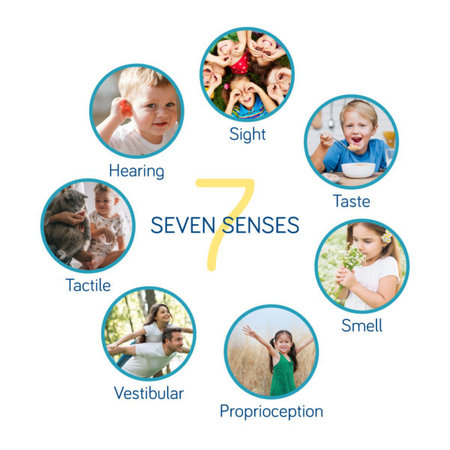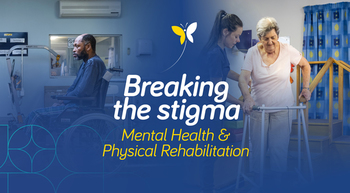
Sensory Regulation
by Cara Macdonald & Simone Jordaan
Stop… Look Around…
Try to Identify:
5 things you can see
4 things you can feel (hand, against your skin)
3 things you can hear
2 thing you can smell
1 thing you can taste
We just made you aware of what your brain is constantly doing – processing sensory information. Every day our brain processes information from our senses – there are 7! You may be confused – let us tell you more…

Information gathered by the senses can either have a calming effect OR they can irritate us.
- Some people are more overwhelmed by sensory input (going to the mall is too stressful due to all the sounds and movement of people)
- other people might not even notice (they can concentrate in a very busy work environment)
- or even enjoy exaggerated sensory experiences (like very loud music, and roller coasters)
You may experience any of the following:
- Emotionally reactive to situations or events that seem overwhelming, and/or having difficulty identifying why you are upset or what caused you to react
- Difficulties with balance
- Trouble sitting still
- Poor attention and focus
- Disorganisation
- Accident-prone, clumsiness
- Poor coordination
- Difficulty tolerating strong lights, smells, or sounds
- Uncomfortable with a physical touch from others (hugging, cuddling)
- Problems tolerating clothing, bathing, grooming, dentists or doctors
- Poor posture
- Overwhelmed by shopping at stores or malls
- Problems with driving or parking
- Limited decision making and problem-solving skills
- Overwhelmed by crowds
- Fear of heights, elevators, escalators, and/or stairs
- Problems with relationships or socialising related to any of the above issues
Look at the difficulties some people may experience in each sensory system and possible strategies that may help regulate our sensory experience.
Visual
Sensitivity Symptoms
- Sensitive to sunlight or fluorescent light
- Overly distracted wall decorations
- Poor eye-hand coordination
- Difficulty tracking across the page to read
- Difficult to copy things to a page
- Complains of headaches
- Skip words when reading
- Lose your place when reading
- Poor handwriting and drawing skills
Activity Suggestions
- Decrease wall decorations
- Adjust light in the room – use blinds, curtains, dim switch, etc
- Use table easel to bring working surface in an upright position
- Window guides or coloured overlays to read
- Copy a page or book at close range instead of from a board
- Make sure screens (computers) are at a proper height
- Do eye-hand activities – juggling, balloon tossing, ball toss, jump rope, target practice, etc.
Oral
Sensitivity Symptoms
- Avoids certain textured food
- Difficulty with new food
- Gags, chokes and/or drools often
- Problems swallowing or chewing
- Avoids mushy food
- Food cravings
- Prefers spicy or hot food
- Bites frequently
- Chews/bites nails
- Mouths non-food items
- Chews on collar or pencils, etc.
Activity Suggestions
- Blow bubbles
- Chew gum
- Chew hard candy
- Drink from a water bottle with a vale
- Drink thick liquid (Yogi Sip) through a thin straw
- Try one new food before dinner
- Wear an edible necklace or bracelet
- Vibrating toothbrush
Vestibular
Sensitivity Symptoms
- Upset when movement is forced on you
- Uncomfortable with fast movement/spinning
- Craves spinning or swinging
- Fearful of heights
- Fear of falling – avoids stairs/hold tight to handrails
- Difficulty standing still / Constantly fidgeting
- Can be impulsive / Takes unsafe risks
- Can be stubborn
- Can be clumsy
- The tendency to be carsick /motion sick – can also manifest as falling asleep immediately in a car, bus, aeroplane or boat
Activity Suggestions
- Use a ball, chair or wiggle cushion for seated position
- Take regular movement breaks
- Jump on a trampoline
- Swinging
- Riding a bike
- Yoga poses
- Use a scooter board
- Sit on a spin chair
- Balance beams or lines
- Jump rope
- Scooter board
Auditory
Sensitivity Symptoms
- Cries, screams/becomes angry with loud /sudden noise
- Has strong emotions when noise volume increases
- Covers ears frequently to sound
- Hides in social situations
- Avoids everyday noise eg: using vacuum
- Bothered by high pitched noise like whistles, violins, chalk on chalkboard
- Distressed by metallic sounds eg: silverware clinking
- Prefers loud music
- Seems to use an ‘’outside voice”
- The tendency to make noise with mouth
- Seems calmed by noises eg: the humming of an air conditioner
- Distracted by sounds such as ticking clock or humming or refrigerator
Activity Suggestions
- Noise-cancelling headphones
- Connect movement to sound
- Quiet room or space to retreat
- Earplugs
- Calming music
- Pre-recorded books
- Musical instruments
Proprioception
Sensitivity Symptoms
- Appears lazy or lethargic
- Avoids active activities, such a running, climbing
- Can be a picky eater
- Avoids touch from others
- Seems uncoordinated
- Bumps into objects or people
- Walk on toes
- Uses extreme force to do things
- Walks loudly or stomps
- Needs to look to do familiar activities
- Difficulty using stairs
- Kicks, bites or hits
- Poor personal space
- Prefers tight clothing
- Chews clothing, fingers, pencils
Activity Suggestions
- Massages
- Carrying or lifting heavy objects
- Cleaning the house
- Wall pushes
- Yoga stretches
- Kneading
- Trampoline
- Jump rope
- Jogging / running
- Bear hugs
- Hugging machine
- Weighted blankets
- Weighted shoulder pad
Tactile
Sensitivity Symptoms
- Avoids certain textures of clothing
- Irritated by labels inside clothing, seams, socks or belt
- Extremely ticklish
- Dislikes hands/face being dirty /are always dirty and messy
- Dislikes having hands or face washed
- Can be a picky eater
- Can crave certain tastes such as salty or sweet
- Avoids hugs and physical contact
- Fearful in large crowds
- Overreacts to light touch
- The constant need to touch other people or objects
- Low impulse control
- Unaware of being touched by others
- Unaware of being injured
- Unaware of pain or overreacts to pain
- Dislikes hair being washed, cut, dried
- Dislike water in the face
- Dislikes showers
- Walk on toes
- Dislikes being barefoot
Activity Suggestions
- Finger painting
- Stress ball made from dough – add flavours, colours, textures
- Sensory Bins
- Weighted blankets
Calming Activities
- Warm bath
- Reduced noise and light levels (no TV, radio, dim lights)
- Deep-pressure activities like massages and bear hugs
- Weighted: Blankets, lap pads, clothing, vests, stuffed animals
- Snug-fitting clothing such as lycra/spandex
- Hugging a stuffed animal
- Petting a pet
- Laying in a beanbag or large pillow
- “Hugging fingers”
- Stretching
- Rocking chairs
- Swinging in a hammock
- Sucking through straws
- Smelling “calm” smells such as vanilla or lavender
- Quiet time
- Fidget toys such as putty or Prestik
- White noise or quiet music with a steady beat
- Squeeze a stress ball tightly and let go
- Squeeze and release playdough, putty, moulding clay
- Heavy work activities – move furniture, laundry, carry groceries
Self Soothing
(Comfort yourself through your five senses)
- Something to touch – stuffed animal, stress ball
- Something to hear – music, nature sounds
- Something to see – snowglobe, happy pictures
- Something to taste – tea, sucking a yogi Sip, popcorn, bubblegum, biltong, cheese
- Something to smell – lotion, candles, perfume, lavender, vanilla
Calm down ANGER with deep stretches

Belly Breathing
Belly breathing is a great way to calm down when you are upset.
Imagine that there is a balloon in your belly. As you take a big breath in through your nose, try to fill up the balloon so that your belly puffs up.
Now breathe out through your mouth (like blowing a bubble) and let all of the air out of the balloon.
Take slow breaths. Try to count to 4 as you breathe in and count to 4 as you breathe out.
Inhale … 2 … 3 … 4
Exhale … 2 … 3 … 4
Repeat until you are calm. Remember to practice every day until it becomes easy to use when you need it.





